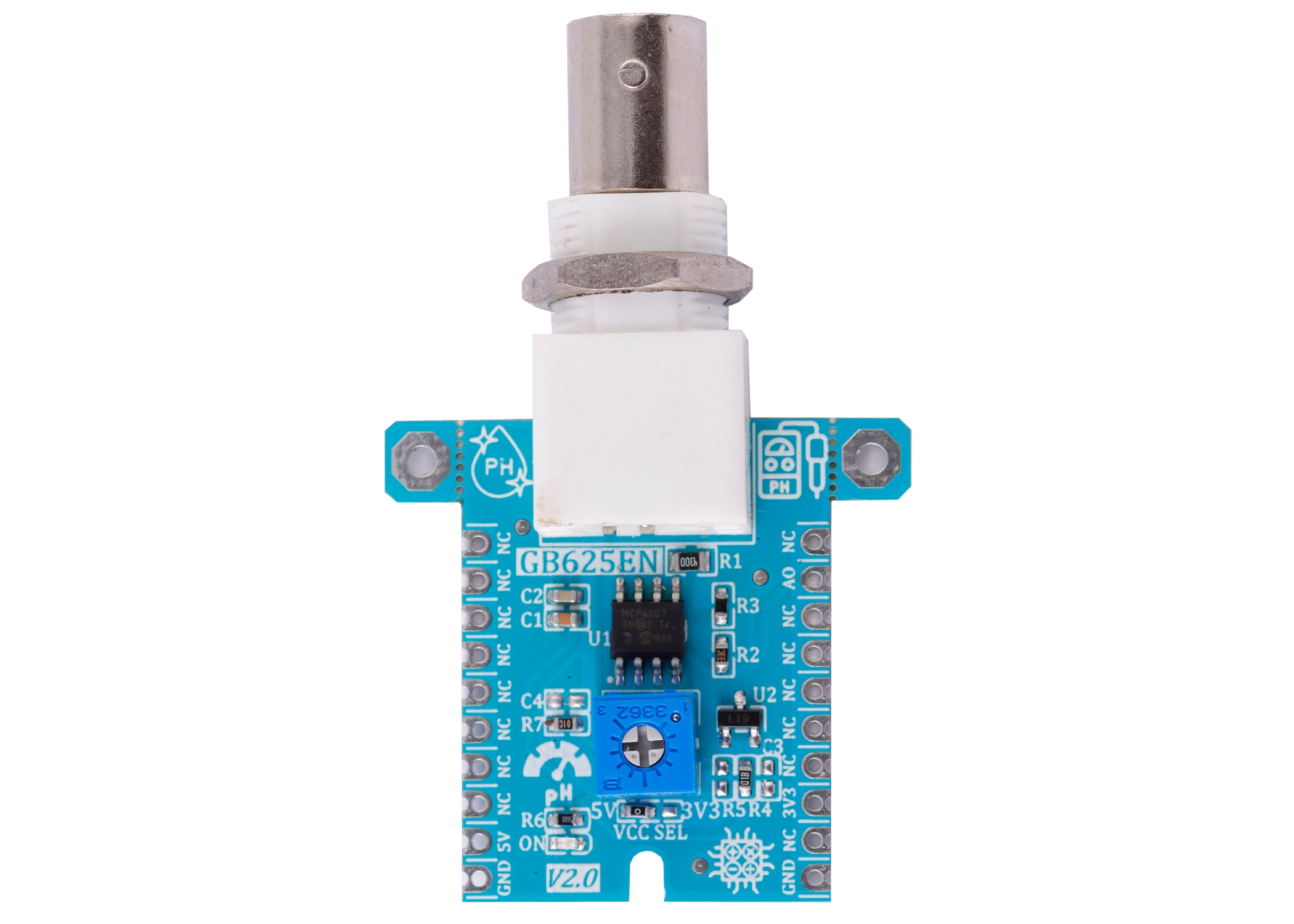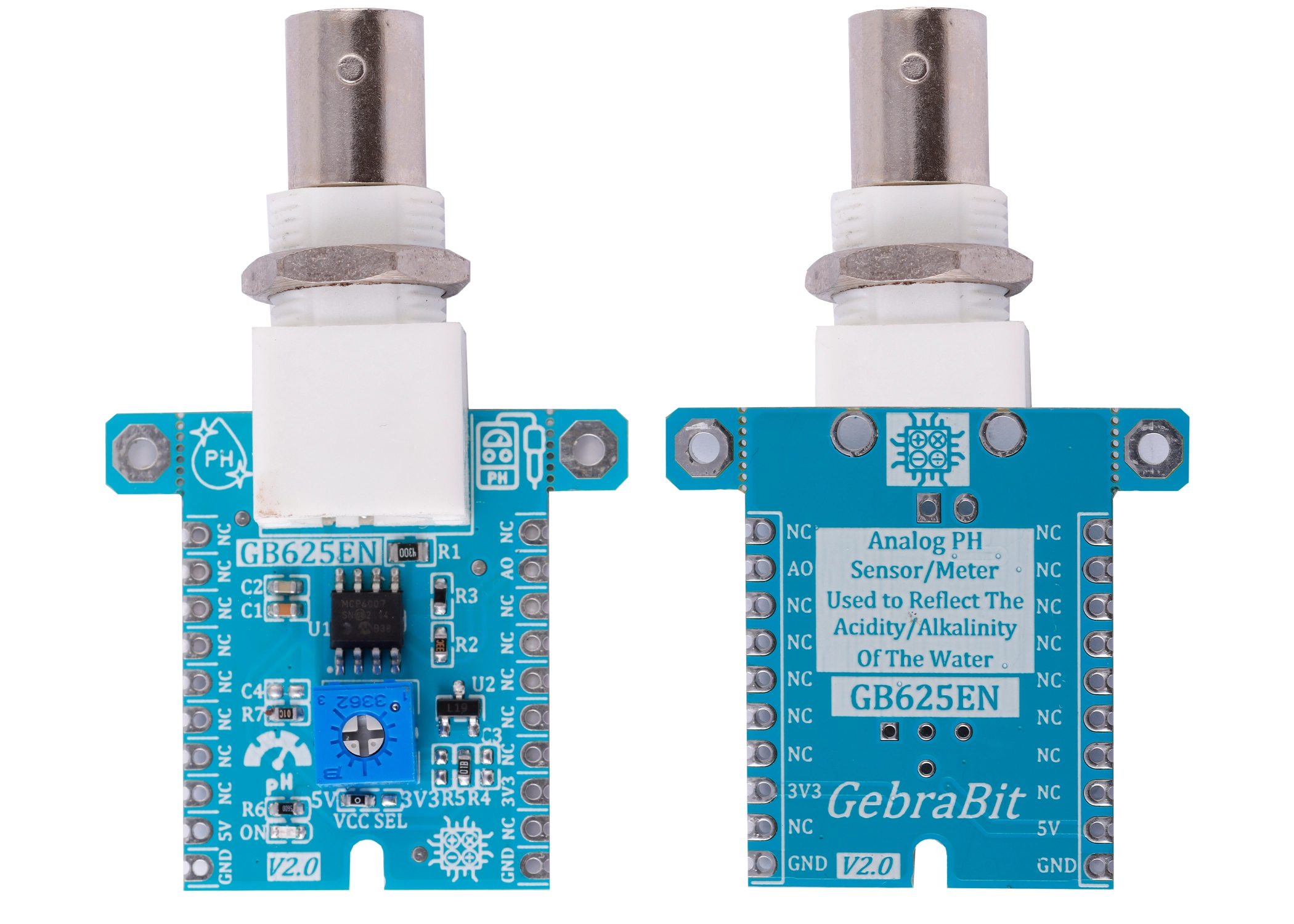The pH is a value that measures the acidity or alkalinity of the solution. It is also called the hydrogen ion concentration index. The pH is a scale of hydrogen ion activity in the solution. The pH has a wide range of uses in medicine, chemistry, and agriculture. Usually, the pH is a number between 0 and 14. Under the thermodynamic standard conditions, pH=7, which means the solution is neutral; pH<7, which means the solution is acidic; pH>7, which means the solution is alkaline.
PH sensor is one of the most important tools for measuring pH and is commonly used in water quality monitoring. This type of sensor is capable of measuring alkalinity and acidity in water and other solutions. When used properly, pH sensors can ensure the safety and quality of products and processes that occur in wastewater or manufacturing plants.
GebraBit PH module

GEBRABIT PH module represents the hydrogen ion concentration in pH units.
A pH sensor is one of the essential tools that are typically used for water measurements. This type of sensor can measure the amount of alkalinity and acidity in water and other solutions.
The standard pH scale is usually represented by a value ranging from 0-14. When a substance has a pH value of seven, this is considered to be neutral. Substances with a pH value above seven represent higher amounts of alkalinity, whereas substances with a pH value lower than seven are believed to be more acidic.

To access the output data, it is enough to put the GebraBit PH module in the BreadBoard, then by applying the proper voltage set up the GebraBit PH module with any of Arduino, Raspberry Pi, Discovery board, and especially we recommend using GebraBit microcontroller development modules (GebraBit STM32F303 or GebraBit ATMEGA32 module) then receive the data.

The reason for our recommendation when setting up the GebraBit PH module with GebraBit microcontroller development modules (such as GebraBit STM32F303 or GebraBit ATMEGA32), is the presence of a 3V3 regulator and the compatibility of the pin order of all GebraBit modules together (GEBRABUS standard), it’s enough to Put the GebraBit PH module in the corresponding socket and develop the desired sensor module without the need for wiring.
GebraBit PH module Key Features
- User-selectable module power supply voltage between 3V3 and 5V
- On Board, ON/OFF LED indicator
- GEBRABIT Pin Compatible with GEBRABUS
- GEBRABIT small package
- It can be used as a daughter board of GEBRABIT MCU Modules
- Featuring Castellated pad (Assembled as SMD Part)
- Separatable screw parts to reduce the size of the board
Introduction of module sections

BNC connector
The GebraBit PH module requires a pH meter probe that is placed in the solution to measure pH. The pH probes contain two electrodes (a sensor electrode and a reference electrode) that measure the hydrogen-ion activity in a solution. The exchange of ions generates a voltage that is measured by the pH meter converting the voltage into a readable pH value. A solution with a high amount of hydrogen-ion activity is an acid. In contrast, a solution with a high amount of hydroxide ion activity is a base.
A BNC connector is used to connect the PH probe to the module, which is placed on top of the module.

Op-Amp circuit
As mentioned, the pH value must be converted into a readable value. In this module, an op-amp circuit is used to amplify the output.

Threshold potentiometer
In the GebraBit PH module, a potentiometer is used to determine the sensitivity threshold.

VCC SEL
According to the state of 0R resistance of this jumper, the sensor supply voltage is selected between 5V and 3V3.

Power LED
According to the status of the module power selector jumper and by applying voltage to the module through the corresponding pin, the LED of the module turns on.

GebraBit PH Module pins

Supply pins
- 3V3 and 5V: These pins can supply the power supply of the sensor circuit according to the state of the power voltage selector jumper.
- GND: This is the ground pin for powering the sensor.

Output pin
- AO: This pin is used to receive the analog output of the module and outputs the PH value as an analog voltage.

Connect to the processor

Connection with GebraBit STM32F303
Due to the compatibility of the pin order of GebraBit modules with each other (GEBRABUS standard), to start the GebraBit PH module with GebraBit STM32F303 microcontroller module, it is enough to easily place the GebraBit PH module as pin to pin on the GebraBit STM32F303 module and start the module by applying voltage. Here, for better understanding, the separate connection of these two modules is shown:

Connection with GebraBit ATMEGA32A
Due to the compatibility of the pin order of GebraBit modules with each other (GEBRABUS standard), to start the GebraBit PH module with the GebraBit ATMEGA32A microcontroller module, it is enough to easily place the GebraBit PH module as pin to pin on the GebraBit ATMEGA32A module and start the module by applying voltage. Here, for better understanding, the separate connection of these two modules is shown:

Note: If you use GebraBit microcontroller modules, make sure that the VCC SEL selector jumper of GebraBit PH module is set to “3V3” so that you can easily get “3V3” voltage from the microcontroller module.
Connection with ARDUINO UNO
Follow the steps below to connect the GebraBit PH module to ARDUINO UNO:
- Connect the “5V” pin of the PH module to the “5V” pin of the ARDUINO UNO board output (red wire).
- Connect the “GND” pin of the PH module to the “GND” pin of the ARDUINO UNO board. (Black wire)
- Connect the “AO” pin of the PH module to one of the ARDUINO UNO board analog pins (orange wire).
How to connect the above mentioned steps can be seen in this picture:




